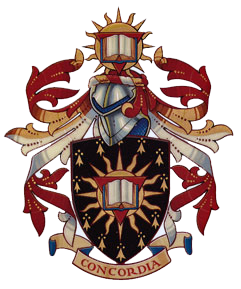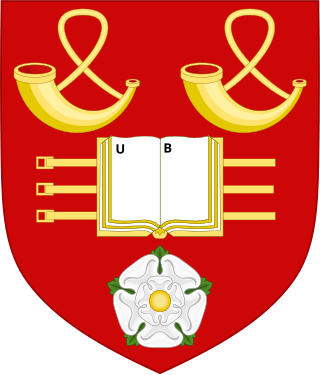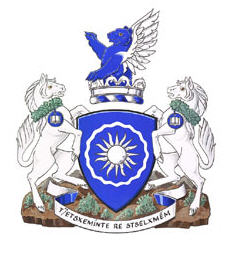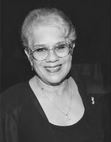
Cape Breton University (CBU) is a public university located in Sydney, Nova Scotia, Canada. It is the only post-secondary degree-granting institution within the Cape Breton Regional Municipality and on Cape Breton Island. The university is enabled by the Cape Breton University Act passed by the Nova Scotia House of Assembly. Prior to this, CBU was enabled by the University College of Cape Breton Act (amended). The University College of Cape Breton's Coat of Arms were registered with the Canadian Heraldic Authority on May 27, 1995.

The University of Manitoba is a public research university in Winnipeg, Manitoba, Canada. Founded in 1877, it is the first university of Western Canada. Both by total student enrolment and campus area, the University of Manitoba is the largest university in the province of Manitoba. Its main campus is located in the Fort Garry neighbourhood of Winnipeg, with other campuses throughout the city: the Bannatyne Campus, the James W. Burns Executive Education Centre, the William Norrie Centre, and the French-language affiliate, Université de Saint-Boniface in the Saint Boniface ward.

Concordia University is an English-language public research university located in Montreal, Quebec, Canada. Founded in 1974 following the merger of Loyola College and Sir George Williams University, Concordia is one of the three universities in Quebec where English is the primary language of instruction. As of the 2022–23 academic year, there were 49,898 students enrolled in credit and non-credit courses at Concordia, making the university among the largest in Canada by enrollment. The university has two campuses, set approximately 7 kilometres apart: Sir George Williams Campus is the main campus, located in the Quartier Concordia neighbourhood of Downtown Montreal in the borough of Ville Marie; and Loyola Campus in the residential district of Notre-Dame-de-Grâce. With four faculties, a school of graduate studies and numerous colleges, centres and institutes, Concordia offers over 400 undergraduate and over 120 graduate programs and courses.

The University of Western Ontario is a public research university in London, Ontario, Canada. The main campus is located on 455 hectares of land, surrounded by residential neighbourhoods and the Thames River bisecting the campus's eastern portion. The university operates twelve academic faculties and schools.

The University of British Columbia (UBC) is a public research university with campuses near Vancouver and Okanagan in British Columbia, Canada. Established in 1908, it is the oldest university in British Columbia. With an annual research budget of $773 million, UBC funds over 10,000 projects a year.
The University of Technology Sydney (UTS) is a public research university located in Sydney, New South Wales, Australia. The university was founded in its current form in 1988, though its origins as a technical institution can be traced back to the 1870s. UTS is a founding member of the Australian Technology Network (ATN), and is a member of Universities Australia (UA) and the Worldwide Universities Network (WUN).

The University of Bradford is a public research university located in the city of Bradford, West Yorkshire, England. A plate glass university, it received its royal charter in 1966, making it the 40th university to be created in Britain, but can trace its origins back to the establishment of the industrial West Yorkshire town's Mechanics Institute in 1832.

Edinburgh Napier University is a public university in Edinburgh, Scotland. Napier Technical College, the predecessor of the university, was founded in 1964, taking its name from 16th-century Scottish mathematician and philosopher John Napier. The technical college was inaugurated as a university in 1992 by Lord Douglas-Hamilton, becoming Napier University. In 2009, the university was renamed Edinburgh Napier University.

Thompson Rivers University is a public teaching and research university offering undergraduate and graduate degrees and vocational training. Its main campus is in Kamloops, British Columbia, Canada, and its name comes from the two rivers which converge in Kamloops, the North Thompson and South Thompson. The university has a satellite campus in Williams Lake, BC and a distance education division called TRU-Open Learning. It also has several international partnerships through its TRU World division. TRU is accredited by the Northwest Commission on Colleges and Universities (NWCCU) at the associate, baccalaureate and master's degree levels.

The University of the West Indies (UWI), originally University College of the West Indies, is a public university system established to serve the higher education needs of the residents of 18 English-speaking countries and territories in the Caribbean: Anguilla, Antigua and Barbuda, The Bahamas, Barbados, Belize, Bermuda, British Virgin Islands, Cayman Islands, Dominica, Grenada, Guyana, Jamaica, Montserrat, Saint Kitts and Nevis, Saint Lucia, Saint Vincent and the Grenadines, Trinidad and Tobago, and Turks and Caicos Islands. Each country is either a member of the Commonwealth of Nations or a British Overseas Territory.

Delhi University, formally the University of Delhi, is a collegiate research central university located in Delhi, India. It was founded in 1922 by an Act of the Central Legislative Assembly and is recognized as an Institute of Eminence (IoE) by the University Grants Commission (UGC). The university has 16 faculties and 86 departments distributed across its North and South campuses, and remaining colleges across the region. It has 91 constituent colleges. Delhi University is one of the largest university systems in the world with over 400,000 students on its campuses and affiliated colleges. The Vice President of India serves as the university chancellor. The university is ranked 11th by National Institutional Ranking Framework 2023.

The University of Karachi is a public research university located in Karachi, Sindh, Pakistan. Established in June 1951 by an act of Parliament and as a successor to the University of Sindh, the university is a "Sindh Government University" and designed by Mohsin Baig as its chief architect.

The University of Dar es Salaam (UDSM) is a public university located in Ubungo District, Dar es Salaam Region, Tanzania. It was established in 1961 as an affiliate college of the University of London. The university became an affiliate of the University of East Africa (UEA) in 1963, shortly after Tanzania gained its independence from the United Kingdom. In 1970, UEA split into three independent universities: Makerere University in Uganda, the University of Nairobi in Kenya, and the University of Dar es Salaam in Tanzania.

The University of the Highlands and Islands (UHI) is an integrated, tertiary institution encompassing both further and higher education. It is composed of 12 colleges and research institutions spread around the Highlands and Islands, Moray and Perthshire regions of Scotland. UHI offers further education, undergraduate, postgraduate and research programmes which can be studied at a range of locations across the area and online. It has 31,000 students, including 19,779 further education students and 11,210 higher education students.

Strathmore University is a chartered university based in Nairobi, Kenya.

The University of Florida Institute of Food and Agricultural Sciences (UF/IFAS) is a teaching, research and Extension scientific organization focused on agriculture and natural resources. It is a partnership of federal, state, and county governments that includes an Extension office in each of Florida's 67 counties, 12 off-campus research and education centers, five demonstration units, the University of Florida College of Agricultural and Life Sciences, three 4-H camps, portions of the UF College of Veterinary Medicine, the Florida Sea Grant program, the Emerging Pathogens Institute, the UF Water Institute and the UF Genetics Institute.

Dr. Betsy Vogel Boze, is an American academic and higher education administrator who is currently serving as the ninth President of The College of The Bahamas. Previously, she worked as a professor of marketing, department chair, dean, and CEO of Kent State University at Stark, before serving as the president of The College of The Bahamas. She is a senior fellow at the American Association of State Colleges and Universities (AASCU), that researches alternative revenue streams for public colleges and universities.

University of Ilorin, also known as Unilorin, is a federal government-owned university in Ilorin, Kwara State, Nigeria. The university sits on an expansive area of land, about 15,000 hectares in the ancient city of Ilorin; making it the largest university in Nigeria and one of the largest in Africa by landmass. The university comprises 17 faculties and over 100 academic departments. It was established by a decree of the federal military government in August, 1975. The establishment aimed to implement one of the educational directives of the Third National Development Plan, which was aimed at providing more opportunities for Nigerians aspiring to acquire university education and to generate high-level manpower, which is vital for the rapidly expanding economy. Compared to other higher institutions of learning in the country, the institution has one of the largest land areas, covering approximately 15,000 hectares of land. It is reported by Joint Admission Matriculation Board (JAMB) to be the most sought-after Nigerian university in 2021. And again in 2023, it was announced by the JAMB Head, Professor Ishaq Oloyede to be the sought-after University, for the 2023 Unified Tertiary Matriculation Examinations (UTME), making it for the 10th consecutive year.

Education in the Bahamas is compulsory between the ages of 5 and 16. As of 2003, the school attendance rate was 92% and the literacy rate was 95.5%. The government fully operates 158 of the 210 primary and secondary schools in The Bahamas. The other 55 schools are privately operated. Enrollment for state primary and secondary schools is 50,332, with more than 16,000 students attending private schools. Some public schools lack basic educational materials and are overcrowded. The Bahamas Union of Teachers (BUT) were the ones who acted to create some reform for their weakening education systems. The island has an Education Act that was revised in 1996 and is under control of the Prime Minister. As of 1996, the Education Act states that education is free for children between the ages of 5 and 16. The University of the Bahamas, established in Nassau in 1974, provides programs leading to bachelors and associate degrees. Several non-Bahamian colleges also offer higher education programs in The Bahamas. Generally, the academic year in The Bahamas goes from late August or early September to late May or early June for primary and secondary schools and late April/early May for college.

Keva Marie Bethel, CMG was a Bahamian educator and the first president of the College of the Bahamas.

























